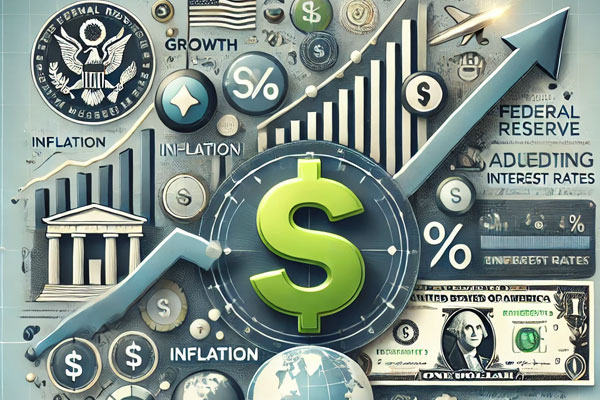Growth and Inflation on the Greenback: Economic Impact Guide
Growth and Inflation on the Greenback” refers to the dynamic relationship between the U.S. dollar’s strength and the country’s economic conditions, including inflation rates and overall economic growth. As inflation rises, the dollar’s purchasing power may decrease, impacting global markets, trade balances, and investor decisions. On the other hand, periods of economic growth can strengthen the Greenback, leading to shifts in monetary policy and interest rates. Understanding these fluctuations is crucial for investors, economists, and businesses tracking the U.S. economy and global financial trends.
The United States dollar (USD), as the world’s primary reserve currency, holds significant global significance. Its strength, influenced by factors such as financial growth and inflation, often serves as a barometer for global economic health. This essay delves into the potential impact of US growth and inflation on the future trajectory of the greenback in the foreign exchange market, particularly the Japanese yen (JPY).
Growth and Inflation on the Greenback
affect the U.S. dollar’s value in global markets, influencing trade and investment.
Strong economic growth in the U.S. typically increases the value of the Greenback by attracting more foreign investment and boosting demand for U.S. assets.
Click to know about Local In-House Financing Car Dealers
With a [specific growth rate] and [specific inflation rate], the US economy has demonstrated remarkable resilience, overcoming numerous challenges, such as the COVID-19 pandemic and its economic aftermath. The Federal Reserve’s accommodation monetary policy and substantial fiscal stimulus measures have propelled the US economy toward a robust recovery. This growth trajectory, if sustained, has the potential to strengthen the USD, signaling to investors and market participants the relative robustness of the US economy compared to other major economies and potentially offering promising investment opportunities.
| Aspect | Explanation |
|---|---|
| Definition | The interaction between U.S. economic growth and inflation’s impact on the value of the U.S. dollar (Greenback). |
| Growth Impact | Strong economic growth usually strengthens the Greenback by attracting foreign investments and increasing demand. |
| Inflation Impact | Rising inflation decreases the purchasing power of the Greenback, potentially weakening its value. |
| Monetary Policy | The Federal Reserve may raise interest rates to combat inflation, strengthening the Greenback, or lower rates to boost growth. |
| Global Impact | Changes in the value of the Greenback affect global trade, commodities, and currency exchange rates. |
| Investor Response | Investors may adjust portfolios based on interest rate hikes or inflationary pressures affecting the Greenback. |
| Consumer Impact | Inflation reduces consumer purchasing power, while controlled growth can lead to increased wages and spending. |
| Central Bank Reaction | The Federal Reserve uses tools like interest rate adjustments to control inflation and influence growth. |
| Trade Balance Effects | A strong Greenback makes U.S. exports more expensive and imports cheaper, affecting the trade balance. |
| Future Outlook | Dependent on economic policy, inflation trends, and global market conditions influencing the Greenback’s value. |
Inflation is another crucial factor that can influence the value of the USD. The recent surge in inflation, albeit partly due to ‘transitory factors’-temporary disruptions in supply chains or pent-up demand after a crisis-has led to speculation about the Federal Reserve’s future monetary policy actions. Should inflation persist at elevated levels, the Fed may consider tightening its monetary stance, which could provide further support to the USD. Conversely, a dovish approach from the Fed could exert downward pressure on the greenback.

The interplay between US growth and inflation is significant not only for the USD domestically but also in the context of its exchange rate with the Japanese yen. Historically, the USD/JPY exchange rate has been sensitive to shifts in US economic fundamentals, as seen in [specific historical event or period]. A strengthening US economy, accompanied by rising inflation, could lead to an appreciation of the USD against the JPY. This potential appreciation may have significant implications for trade dynamics, investment flows, and the overall economic relationship between the two countries, impacting businesses and investors on both sides.
Click to learn about Bad Credit Financing for ATV
It is crucial to consider the broader implications of a stronger USD in the global context. A robust greenback can have diverse effects on different economies and asset classes. For instance, a stronger USD may exert downward pressure on commodity prices, significantly impacting countries reliant on commodity exports such as [specific country]. Furthermore, emerging market economies with substantial USD-denominated debt may face significant challenges in servicing their obligations as the USD strengthens, as seen in the case of [specific country]. This underscores the critical role of policymakers in monitoring and managing these potential risks.
Market Expectations and Speculation
- The foreign exchange market reacts quickly to changing economic indicators, Federal Reserve policies, and other macroeconomic data. Speculators often trade the dollar based on expectations of future growth and inflation trends. For example, if the market expects inflation to rise, they might sell the dollar in anticipation of a decline in value. Similarly, if economic growth appears robust, the dollar might appreciate due to higher expectations for returns on U.S. assets.
Recent Trends (2023-2024)
- In recent years, inflationary pressures have been elevated due to supply chain disruptions, rising commodity prices, and the effects of expansive fiscal and monetary policies in response to the COVID-19 pandemic. The Federal Reserve has raised interest rates to combat inflation, which has supported the dollar, but also created challenges for growth.
- As the U.S. economy navigates through the post-pandemic recovery, investors are keenly watching inflation rates, the Federal Reserve’s actions, and the overall health of the economy to determine the future trajectory of the Greenback.
Conclusion
US growth and inflation are and will continue to be pivotal determinants of the USD’s future trajectory, with potential implications for its exchange rate with the Japanese yen and broader global economic dynamics. A strengthening greenback can signal confidence in the US economy, but it is crucial to monitor its impact on other economies and asset classes. As the global economic landscape continues to evolve, the dynamics of the USD and its relationship with US growth and inflation will remain a focal point for investors, policymakers, and market participants, underscoring the ongoing relevance and importance of this topic.
What is the relationship between growth and inflation on the Greenback?
The relationship between growth and inflation on the Greenback refers to how the U.S. economy’s expansion or contraction affects inflation and the value of the dollar. Economic growth can strengthen the dollar, while high inflation can erode its purchasing power.
How does inflation impact the value of the Greenback?
Inflation decreases the purchasing power of the Greenback, meaning each dollar buys fewer goods and services. As inflation rises, the Greenback tends to weaken against other currencies.
What effect does economic growth have on the Greenback?
When the U.S. economy experiences growth, it often strengthens the Greenback as demand for the currency increases due to higher interest rates and increased foreign investments.
How do central banks respond to growth and inflation on the Greenback?
Central banks, like the Federal Reserve, adjust interest rates in response to inflation and growth trends. To combat high inflation, they may raise interest rates, which can strengthen the Greenback. During periods of low growth, they may lower rates to stimulate the economy.
What factors influence both growth and inflation on the Greenback?
Key factors include U.S. monetary policy, interest rates, consumer demand, energy prices, and global economic conditions. Trade balances and geopolitical events can also impact both growth and inflation on the Greenback.
How does inflation on the Greenback affect global markets?
Inflation on the Greenback affects global markets by influencing exchange rates, trade dynamics, and investment flows. A weaker Greenback can make U.S. exports cheaper but may reduce foreign investment in dollar-denominated assets.
Can the Greenback grow stronger while inflation is rising?
Yes, if the Federal Reserve increases interest rates to combat inflation, the Greenback can become stronger as higher rates attract foreign investment, even during inflationary periods.
What is the long-term outlook for growth and inflation on the Greenback?
The long-term outlook depends on various factors, including U.S. fiscal policy, global economic trends, and inflation control measures. Economic stability and effective inflation management are key to maintaining the Greenback’s strength.
How do investors respond to growth and inflation on the Greenback?
Investors often look for safe-haven assets, adjust their portfolios based on interest rates, and hedge against inflation when inflationary pressures affect the Greenback. Currency traders also monitor these trends to make informed decisions.
How are consumers affected by growth and inflation on the Greenback?
Consumers may see rising prices during inflation, which can reduce their purchasing power. On the other hand, strong economic growth can lead to higher wages and more spending power if inflation is controlled effectively.







